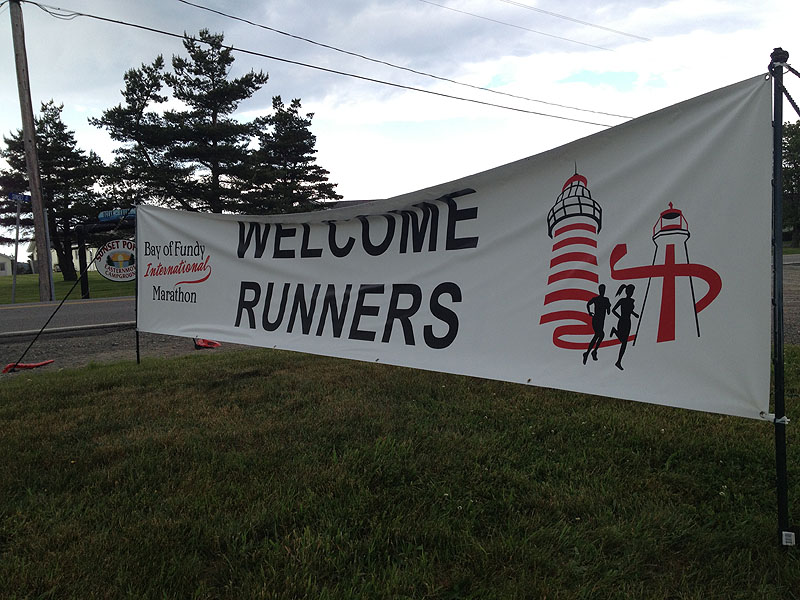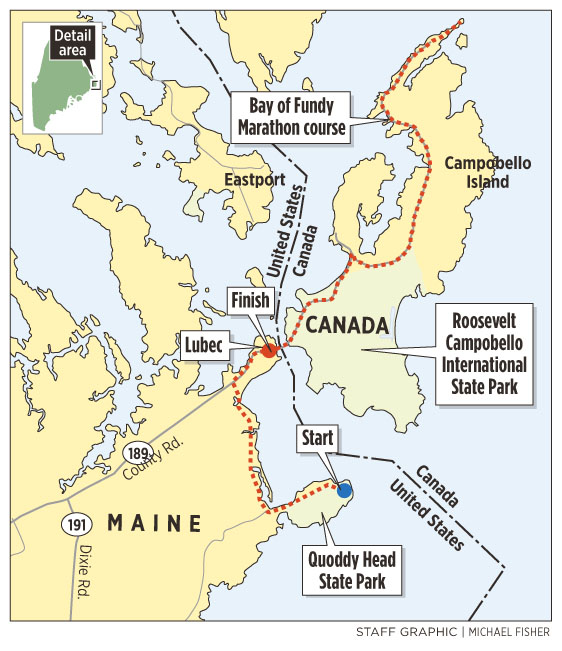LUBEC – Perched at the easternmost tip of both Maine and the nation, tiny Lubec is rarely flooded with visitors. It’s too remote: an hour from the nearest stoplight, more than two to the nearest Starbucks or airline terminal.
Campobello, its nearest neighbor across the FDR Memorial Bridge, is even more isolated: a Canadian island community whose residents have no direct access to the rest of Canada 10 months of the year, and must drive there via Lubec and a great swath of eastern Washington County.
But the two towns — with but 2,400 people between them — are braced for what may be the largest influx of weekend visitors in their history: 800 runners and at least as many guests and spectators arriving for the first Bay of Fundy International Marathon, which takes place Sunday.
The number of runners — who come from 37 states and nine countries — is quadruple the number originally expected by the race’s organizers, an all-volunteer group that sees the race as an opportunity to give the struggling Down East region an economic boost and increased exposure.
“We were thinking it would be wonderful if we could get 200 runners, and then we hit 800 and had to close registration. We’re very excited about it,” says Sue Keef, the lead organizer on the Canadian side, who owns the restaurant at Campobello’s Herring Cove Provincial Park. “We’re two small towns working together to try to bring tourism and the economy up both this weekend and in the long term.”
Every hotel, motel, and guest house bed is reportedly booked for a 30-mile radius from downtown Lubec, where the finish line is.
The only gas station in the two communities ordered a special fuel delivery Friday to meet expected demand, and islanders were scurrying to do cross-border shopping Thursday before visitors arrive in force.
The communities could use the boost. Campobello has been losing population, especially since the imposition of stricter security and passport requirements by U.S. border officials after the 9/11 attacks scared off tourists and complicated everyday lives that are, by geographical necessity, cross-border in nature.
The island’s only bank and gas station have closed, meaning residents have to drive to or through the U.S. to fill their tanks or interact with the Canadian banking system.
Lubec, a former fishing and sardine canning town, has seen a revival of seasonal main street commerce, but has dozens of boarded-up homes and businesses. The town closed its high school in 2010, and its 37 students now travel nearly two hours each day to attend school in Eastport or Machias.
But the region has a powerful asset: natural beauty staggering even for Maine and New Brunswick. Twenty-foot tides sweep between islands, cliffs, and beaches, many of them part of state, provincial and international parks.
Katherine Cassidy, a former reporter who represents the region in the Maine House of Representatives, thought the international community would make an attractive and exotic setting for marathon runners. She knew something about what draws runners, having covered marathons around the world for national running magazines, for which she traveled as far afield as Darjeeling, Marrakesh, and Bangkok.
“The cross-border, two country experience and the region’s beauty and ruralness — I thought that would be very attractive,” says Cassidy, who recently completed a master’s thesis on the economic benefits of first-year marathons in rural settings.
Sunday’s race is also an official qualifying event for the Boston Marathon, and Cassidy suspects part of the surge in interest may be in response to the terror attacks there, as many runners may want to return to Boston in a show of solidarity for the city and its marathon.
She hit on the idea of a Lubec-Campobello marathon several years ago, but thought negotiating with border and customs agencies would be daunting. Surprisingly, it wasn’t. She says local border and customs officials from each country went out of their way to work out solutions and to liaison with superiors in Boston, Ottawa and Washington.
“The border was a big challenge in organizing the event, but from the start they were amazingly cooperative in seeing how we could we make this happen and what could it take and how can we make this work,” says John Hough, a retired international environment and development official who volunteered to take the lead on some of the logistical challenges as the marathon’s race director.
The marathon’s runners actually cross the border twice on their 26-mile trek. The race starts at Lubec’s iconic West Quoddy Head lighthouse, the country’s easternmost point. Entrants will run six miles around the southern and western shores of Lubec Narrows before crossing the international bridge to Campobello, traversing the entire length of the 10-mile island to East Quoddy Head Light and then turning around and returning, across the bridge, to downtown Lubec.
The 500 runners doing the full marathon will have submitted travel documents and pre-cleared customs before the race. On race day — and with customs agents looking on — each will receive a bib with an electronic security tag, allowing them to pass through the border checkpoints. Similar procedures were developed for two other marathons that cross the U.S.-Canada border.
The other 300 registered runners are participating in a 10K race taking place entirely on the U.S. side of the Narrows.
Runners know they are coming to a far-flung, rural locale, but they may still be surprised at just how away from it all Lubec and Campobello are. “We told them we’re a small town with limited accommodations, but I don’t know if they realize just how small we are,” says Cassidy. “We haven’t told them that we’re 130 miles from the nearest Starbucks, that there’s only one gas station, and that there are no cellphones.”
Proceeds from this year’s marathon — the first in what is planned to be an annual event — are to go toward the construction of a memorial to Lubec and Campobello fishermen who have been lost at sea. “It’s a very sensitive subject here because we’ve had local families who have lost members that way, and it’s a very small place so it really touches everybody,” says Keef.
Dozens of local businesses have sponsored mile and kilometer posts, and additional contributions were made by other entities, including the Bar Harbor Bank and Trust, Ocean Renewable Power Co. and associated contractors, Harry S. Martin Insurance, the Campobello Tourism Foundation, the Maine Community Foundation, the government of New Brunswick, and the Roosevelt-Campobello International Park, which is on Campobello, where Franklin Delano Roosevelt had his summer home.
Organizers say the local communities embraced the idea from the outset. On Friday, dozens of volunteers were preparing to deploy water stations and were stuffing goodie bags — nylon lobster bait bags, in fact — for the runners.
“We’re so cheered just from the fact that we’re filling all available accommodations and we’ll have full restaurants for three or four or five days this week — that’s pretty spectacular,” says Cassidy.
“Our ultimate hope would be that among these 800 runners — most of them coming to Lubec and Campobello for the first time — these are Type A people with money to spend and maybe among them will be someone who wants to move here or bring a business here or buy a house and bring his or her family here.”
Colin Woodard can be contacted at 791-6317 or at:
cwoodard@pressherald.com
Send questions/comments to the editors.




Success. Please wait for the page to reload. If the page does not reload within 5 seconds, please refresh the page.
Enter your email and password to access comments.
Hi, to comment on stories you must . This profile is in addition to your subscription and website login.
Already have a commenting profile? .
Invalid username/password.
Please check your email to confirm and complete your registration.
Only subscribers are eligible to post comments. Please subscribe or login first for digital access. Here’s why.
Use the form below to reset your password. When you've submitted your account email, we will send an email with a reset code.